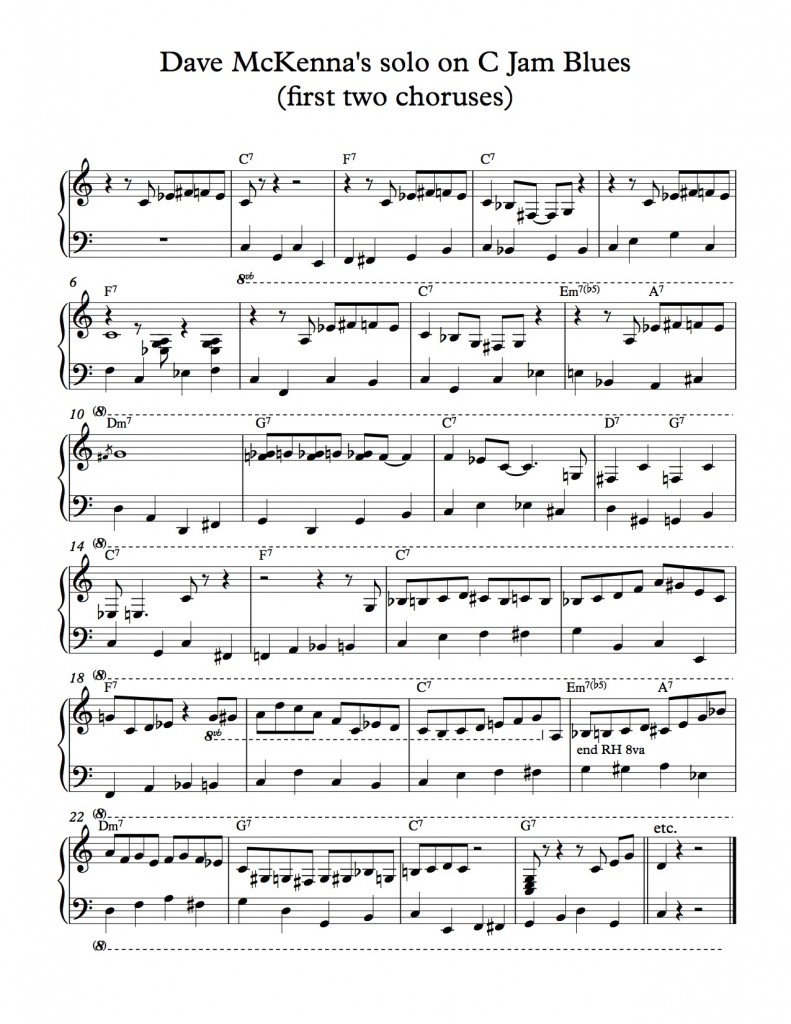The concept of food pairings is one that I’ve learned a great deal about from my wife, Amber deLaurentis, a great pianist, vocalist and songwriter who happens to be an amazing artist in the kitchen as well. In food pairing, one chooses a garnish for the way it brings out the flavor in a salad or a cut of meat; or one chooses a beverage for the way it brings out the flavor in the food it accompanies.
When I studied classical piano repertoire with Elizabeth Metcalfe and Sylvia Parker in the mid to late 1990s, following my studies of jazz with teachers including Yusef Lateef, Archie Shepp, Tom McClung and Bruce Sklar in the late 1980s and early 1990s, I noticed that a number of keyboard techniques I had learned as a jazz player also showed up in classical piano repertoire. The techniques that jazz players call left-hand walking bass, left-hand stride accompaniment and left-hand chordal comping, for example, can all be found in various pieces from standard classical solo piano literature. As a piano teacher, I’ve started to notice that applying a given technique (for instance, walking bass) to a jazz tune can be easier if it is studied side by side with a classical piece that calls for the same technique; the ‘pairing‘ can bring out the ‘flavor‘ in both pieces. To use more technical (and less appetizing) language, the classical pieces can function as etudes that help a jazz player develop facility with a particular technique. Making these kinds of connections with classical repertoire can can also introduce jazz pianists to the value and relevance of studying classical solo piano literature in general, as a way to build technique, develop their sound. and as an end in itself. This is the first in a series of posts on pairings of classical and jazz pieces that can be useful (and hopefully enjoyable) in the practice room (and maybe also in adventurously programmed performances.)
In first couple pairings I’ll be connecting classical pieces with transcriptions from two great players, Dave McKenna and John Coates, Jr., who might be called ‘municipal monster pianists.’ Both McKenna and Coates are well-known among fellow musicians and in certain pockets of the listening public despite the fact that they largely avoided the typical touring routine of the professional jazz musician and chose instead to make a long-term commitment to playing solo piano at one venue close to their place of residence. (McKenna played six nights a week throughout the most of the 1980s at the Plaza Bar in the Copley Square Hotel in Boston.) Given their preference for solo piano playing, as well as the fact that they were also great accompanists, it is no coincidence that McKenna and Coates both mastered the technique of walking bass lines with the left hand. The transcription below is an excerpt from a Dave McKenna version of ‘C Jam Blues’ which can be heard and seen on YouTube. (The tune begins at :29 on the video; one of the reasons I chose to transcribe this ‘C Jam Blues’ is that it’s a notch or two slower than McKenna’s commercially released versions of the tune.) McKenna combines an eighth-note-based solo full of bop-style melodic invention with a quarter-note bass line where he manages to be inventive while also keeping his left hand largely below C3. I suggest first learning to play the head of ‘C Jam Blues’ in the right hand while playing the first twelve bars of walking bass in the left, and then learning McKenna’s solo line in the right hand. (I have found the right hand pattern in m. 16-17 particularly fun to transpose through the circle of descending fifths while playing dominant 7th chords through the circle of fifths in the left hand.)
Walking bass was also a common technique in the Baroque era; the bass lines in J.S. Bach’s orchestral music, for example, are often nearly as strong and independent as the melodic lines further up in the contrapuntal texture. A microcosm of this bass independence can be heard in the Gavotte from his English Suite in G Minor. Although the left hand bass line alternates between quarter-note walking and brief flurries of eighth notes, there are enough eighth notes in the right hand line that I find it the piece comparable to a jazz situation with walking bass and an improvised eighth-note line.
Finally, I discovered the Allemande from Handel’s Keyboard Suite in B Flat Major through a recording by Keith Jarrett, who first became known as a jazz pianist but is also known today through his classical recordings. This piece combines the same kind of quarter-note walking bass with an eighth-note-based melody slightly less ornate than that of the Bach Gavotte. As the Jarrett recording is not available on YouTube, I have linked to the recording by Andras Schiff
I encourage pianists looking to develop their facility with walking bass to try practicing either the Bach or the Handel side by side with my McKenna transcription. In an upcoming post I will look at how great jazz pianists combine left hand walking and right hand chordal comping in duo situations.